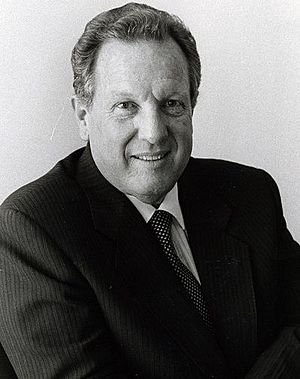Rodrigo Carazo Odio facts for kids
Quick facts for kids
Rodrigo Carazo Odio
|
|
|---|---|
 |
|
| 38th President of Costa Rica | |
| In office 8 May 1978 – 8 May 1982 |
|
| Vice President | Rodrigo Altmann Ortiz José Miguel Alfaro Rodríguez |
| Preceded by | Daniel Oduber Quirós |
| Succeeded by | Luis Alberto Monge Álvarez |
| Personal details | |
| Born | 27 December 1926 Cartago, Costa Rica |
| Died | 9 December 2009 (aged 82) San José, Costa Rica |
| Political party | Unity Coalition (Current Social Christian Unity Party) |
| Spouses | Estrella Zeledón Lizano (m. 1947–2009; his death) |
| Signature | |
Rodrigo José Ramón Francisco de Jesús Carazo Odio (born December 27, 1926 – died December 9, 2009) was the President of Costa Rica from May 8, 1978, to May 8, 1982. He was an important leader who helped shape Costa Rica during a challenging time.
Contents
Early Life and Career
Rodrigo Carazo was born in Cartago. Before becoming president, he held several important jobs. He was the head of the Central Bank, which manages the country's money. He also worked as the General Manager for RECOPE, Costa Rica's national oil company. Later, he served as the President of the Legislative Assembly of Costa Rica from 1966 to 1967. This role is similar to being the speaker of a country's parliament.
In 1947, he married Estrella Zeledón Lizano in San José. They had five children together: Rodrigo Alberto, Mario Ernesto, Jorge Manuel, Álvaro, and Rolando Martin. Sadly, their son Rolando passed away in a motorcycle accident in 1979 when he was 26 years old.
Presidency (1978-1982)
During his time as president, Carazo worked on several key projects and faced big challenges.
Education and Energy Initiatives
President Carazo played a major role in starting the University for Peace. This university is linked to the United Nations and offers special programs about peace and development. It was a big step for education and peace studies in the region.
His government also focused on developing Costa Rica's energy and industry. They worked on the petrochemical industry, which deals with products made from oil and natural gas. They even started looking for petroleum near the Talamanca Mountains. In terms of energy, his government opened a large hydroelectric power plant at Lake Arenal. This plant uses water to create electricity. They also set rules for digging for gold in the southern part of the country.
International Relations and Challenges
A major challenge during Carazo's presidency was dealing with the changes in neighboring Nicaragua. For many years, Nicaragua was ruled by the Somoza family, a dictatorship that Costa Rica did not support. When the Sandinista movement grew in the 1970s, Nicaragua faced a civil war.
Costa Rica's government supported the Sandinistas against Somoza. Many battles near the border between the two countries sometimes spilled over into Costa Rican territory. President Carazo warned Somoza to keep his forces on his side of the border. His government even started planning a defense force in case Somoza tried to attack Costa Rica.
The conflict ended in 1979 when the Sandinistas took control of Nicaragua and Somoza went into exile. However, Carazo's government faced criticism from the public. Some people felt he had not fully protected Costa Rica's independence. Later, in 1982, the Central American Democratic Community was formed in San José. This group, supported by the United States, aimed to keep Nicaragua separate from other Central American countries because of its new government. In 1981, Carazo's government also ended all official relations with Fidel Castro's Cuba.
Economic Difficulties
Carazo's presidency was also a tough time for Costa Rica's economy. The world was going through an economic recession. This meant that economies around the globe were slowing down. The price of Petroleum was very high, which made things expensive for Costa Rica. At the same time, the price of coffee, which was Costa Rica's main crop, was falling.
Against the advice of his finance minister and the International Monetary Fund (IMF), President Carazo told the Central Bank to borrow a lot of money. He hoped this would keep the value of the colón, Costa Rica's currency, stable. However, this plan did not work out. In September 1980, the colón suddenly lost a lot of its value. The large amount of debt the Central Bank took on led to very high inflation in Costa Rica, meaning prices for goods and services went up quickly.
After leaving office in 1982, Carazo became a strong critic of the IMF and other global financial organizations. In his later years, he actively spoke out against the Central American Free Trade Agreement (CAFTA).
Later Life
In his later years, Rodrigo Carazo worked to improve relations between North Korea and Western countries. He visited Pyongyang, North Korea's capital, several times in the early 1990s. His efforts helped open unofficial talks between the United States and North Korea.
He was also the first Chairman of the University for Peace and United World Colleges Costa Rica.
Rodrigo Carazo passed away on December 9, 2009, at the age of 82, in San José. He died from heart failure and other organ problems. He was survived by his wife, former First Lady Estrella Zeledón Lizano, and four of their children.
See also
 In Spanish: Rodrigo Carazo Odio para niños
In Spanish: Rodrigo Carazo Odio para niños

